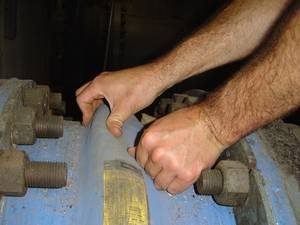
They absorb movement, relieve system strain due to thermal change, stress, pumping surges, wear, or settling, reduce mechanical noise, compensate for misalignment, and/or eliminate electrolysis between dissimilar metals.
When expansion joints are designed, applied, and installed correctly, it is not unusual to achieve a service life of 15-20 years in most industrial applications. Read on to see what our partners at Garlock had to say about troubleshooting in order to expand the life expectancy of nonmetallic expansion joints.
"A robust preventative maintenance program for elastomer expansion joints can improve both plant safety and the mechanical integrity of equipment," Garlock's Sherwin Damdar and Stephen Cramb wrote in 2012.
"Such a program includes a comprehensive, systematic survey of all expansion joints, stocking the proper types and levels of inventory, periodic follow-up inspections, analysis of prematurely failed joints, and ongoing training for plant personnel. "
Such surveys can prevent premature failures, which can cost even more than replacing joints. A survey should gather relevant data for each joint: location, orientation, inside diameter, face-to-face dimensions, as well as any offset or misalignment and the style and general condition of each joint. Depending on the condition, the joint should either be replaced right away or marked for re-inspection in six months.
The survey should include both joints in service as well as the ones in inventory. By inspecting the inventory joints, you can be sure you have the proper type and sufficient number of spares, and that the manufacturer's shelf life hasn't expired. Put a summary of all the expansion joints into a single document.
"After the initial survey has been conducted, all expansion joints should be reinspected, ideally prior to planned shutdowns or scheduled maintenance," Cramp and Damdar write. "Those exhibiting signs of wear can then be replaced from inventory and restocked. Replacing failed or damaged expansion joints not only protects the piping systems in which they are installed, but also provides critical information regarding system conditions at their locations."
Failure analysis
There are perceptible warning signs when an expansion joint is failing:
- Arch inversion indicating a system vacuum that has exceeded the joint's specified expansion value.
- Cracking at the base of the arch, which indicates the joint has been over-elongated and should be replaced with one of the proper length.
- Ply separation on the outside of the cover. This is an indication the joint has been subjected to excessive movement.
Expansion joints can burst, although this is an unusual occurence because most joints are designed with 3:1 or 4:1 safety factors for burst pressures in excess of 1,000 psi. However, it's easy to overlook the gap between the joint's current and original condition.
"For example, in general water service with a relatively low flow rate, ambient temperature, stable system pressure, and minimal movement, an expansion joint could theoretically last up to 20 years," write Damdar and Cramb. "Other applications, such as flue gas desulphurization systems, pump highly abrasive slurry media at high flow rates, accelerating joint wear. Every application is different, so failed expansion joints should be removed and assessed for the root causes of failure."
Typically, expansion joints fail from the inside, where flow conditions can negatively impact the entire assembly.
Of the joint's three basic components, the tube is the most crucial, as it acts as a physical and chemical boundary between the body and media. If the tube is compromised, the body can be exposed to the media, causing a possible degradation.
This is why it is vital that any inspection of a failed expansion joint look at the condition of the tube. In abrasive applications, the media can wear through the tube and body of a joint to the point where only a minimal amount of pressure can lead the tube to leak or burst. In other cases, excessive temperatures may have caused the tube to harden. This in turn causes the tube to lose its resilience and crack under dynamic movement.
"Understanding the root causes of expansion joint failures can provide useful information about the systems in which they were installed, but it is preferable to prevent such failures in the first place," Garlock's Cramb and Damdar write. "The challenge is to develop and deploy a maintenance program to find the visible indicators of potential joint failures and take the necessary preventive action. Frequency of inspections will vary with application conditions. Critical path and high-risk systems may require fairly frequent inspection, whereas less critical ones can be inspected biannually or even annually."
In conclusion, the best way to prevent catastrophic failures is a preventative maintenance program that includes a systematic survey of all expansion joints, stocking the proper types of and levels of inventory, periodic follow-up inspections, analysis of prematurely failed joints, and ongoing training for plant personnel.
Gallagher Fluid Seals has been surveying, designing, and installing expansion joints for decades. We’re prepared to help you with all facets of your expansion joint maintenance program.
